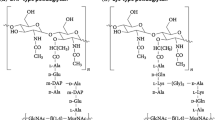Abstract
Although biofilms are often associated with hospital infection problems owing to their high resistance to antimicrobial agents, in recent years biofilms have also been studied in the industrial sector, mainly because they are a major cause of contamination outbreaks in facilities and products. The aim of this study was to investigate whether different materials commonly found in the metalworking industries have different biofilm formation characteristics when in contact with contaminated cutting fluid as well as to establish an optimal concentration of a triazine-based antimicrobial agent to protect the oil/water emulsion and also to delay or interrupt the development of biofilms. Biofilms grown on the surface of carbon steel, stainless steel, aluminum, polyvinyl chloride, and glass were analyzed in terms of cell growth and susceptibility to the tested biocide. The results showed that the type of material used had little influence on cell adhesion or on the microbicide concentration required to control and eradicate microorganisms suspended in the emulsion and in the biofilms.



Similar content being viewed by others
References
Barr ARM (1998) Biological examination and assay of metalworking fluids. Ind Lubr Tribol 50(4):153–156
Capelletti RV, Moraes AM, Lucchesi EG (2005) Proceedings of the XV Simpósio Nacional de Bioprocessos, Recife, Brazil
Ceri H, Olson ME, Stremick C, Read RR, Morck D, Buret A (1999) The Calgary biofilm device: a new technology for the rapid determination of antibiotic susceptibility of bacterial biofilms. J Clin Microbiol 37(6):1771–1776
Christensen BE, Characklis WG (1990) Physical and chemical properties of biofilms. In: Characklis WG, Marshall KC (eds) Biofilms. Wiley, New Jersey, pp 93–130
Cloete TE (2003) Resistance mechanisms of bacteria to antimicrobial compounds. Int Biodeterior Biodegradation 51:277–282
Cook PE, Gaylarde CC (1988) Biofilm formation in aqueous metal working fluids. Int Biodeterior 24(4–5):265–270
Flemming HC, Windenger J (1999) Extracellular polymeric substances (EPS): the biofilm construction material. In: Weber J, Sand W (eds) Biofouling and materials: EDMZ, COST 520 workshop. EDMZ, Bern, pp 2–18
Flemming HC, Wingender J (2010) The biofilm matrix. Nat Rev Microbiol 8:623–633
Guiamet PS, Gómez de Saravia SG (2005) Laboratory studies of biocorrosion control using traditional and environmentally friendly biocides: an overview. Lat Am Appl Res 35(4):295–300
Klemm P, Vejborg RM, Hancock V (2010) Prevention of bacterial adhesion. Appl Microbiol Biotechnol 88:451–459
Lucchesi EG (2006) Desenvolvimento de sistema de obtenção de biofilmes in vitro e a avaliação de sua susceptibilidade a biocidas. Master’s thesis. School of Chemical Engineering, State University of Campinas, Campinas, SP, Brazil
Lutey RW (1995) Process cooling water. In: Rossmore HW (ed) Handbook of biocide and preservative use. Blackie Academic & Professional, Glasgow, pp 51–82
Marques LLR, Manfio GP (2004) Standard procedure for determination of MIC, MBC and MBEC. Workshop on microbial biofilms, Campinas, SP, Brazil
National Institute for Occupational Safety and Health (2001) Metal working fluids—recommendation for chronic inhalation studies. http://ntp.niehs.nih.gov/ntp/htdocs/Chem_Background/ExSumPdf/MWFs.pdf. Accessed Jan 2011
Pasmore M, Costerton JW (2003) Biofilms, bacterial signaling, and their ties to marine biology. J Ind Microbiol Biotechnol 30(7):407–413
Passman FJ (1988) Microbial problems in metalworking fluids. J Soc Tribol Lubr Eng 44:431–433
Passman FJ (1992) Controlling microbial contamination in metal working fluids. In: Metal working fluids, March 16–18, 1992. Society of Manufacturing Engineers, Dearborn, MI. SME Technical Paper MF92-127
Passman FJ (1997) Biocides for lubricant rancidity and biofouling prevention. Iron Steel Eng 74(10):41–45
Passman FJ, Summerfield J, Sweeney J (2000) Field evaluation of a newly registered metalworking fluid biocide. Lubr Eng 56(10):26–32
Schwingel WR, Eachus AC (2009) Antimicrobial additives for metalworking lubricants. In: Rudnick LR (ed) Lubricant additives: chemistry and applications, 2nd edn. CRC, Boca Raton, pp 383–397
Vanderzant C, Splittstoesser D (1992) Compendium of methods for the microbiological examination of foods, 3rd edn. American Public Health Association, New York
Willis AJ, Bott TR (1999) Inhibition of Pseudomonas fluorescens biofilm development by hydrogen peroxide. In: Bott TR (ed) Understanding heat exchanger fouling and its mitigation. United Engineering Foundation, New York, pp 171–175
Wilson M (2001) Bacterial biofilms and human disease. Sci Prog 84(3):235–254
Wimpenny JWT, Peters A, Scourfield MA (1993) The physiology and biochemistry of biofilm. In: Characklis WG, Wilderer PA (eds) Structure and function of biofilms. Wiley, New Jersey, pp 111–127
Acknowledgments
The authors wish to thank IPEL Itibanyl Produtos Especiais Ltda. for its support of this work. We also thank the laboratory analyst Anderson Luis de Oliveira for his help in collecting the data. Ângela Maria Moraes acknowledges the fellowship granted by the National Council for Scientific and Technological Development (CNPq) from Brazil.
Author information
Authors and Affiliations
Corresponding author
Rights and permissions
About this article
Cite this article
Lucchesi, E.G., Eguchi, S.Y. & Moraes, Â.M. Influence of a triazine derivative-based biocide on microbial biofilms of cutting fluids in contact with different substrates. J Ind Microbiol Biotechnol 39, 743–748 (2012). https://doi.org/10.1007/s10295-011-1081-x
Received:
Accepted:
Published:
Issue Date:
DOI: https://doi.org/10.1007/s10295-011-1081-x




